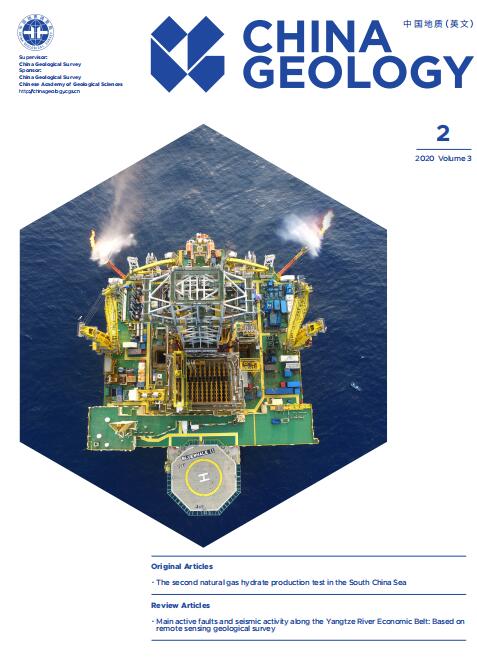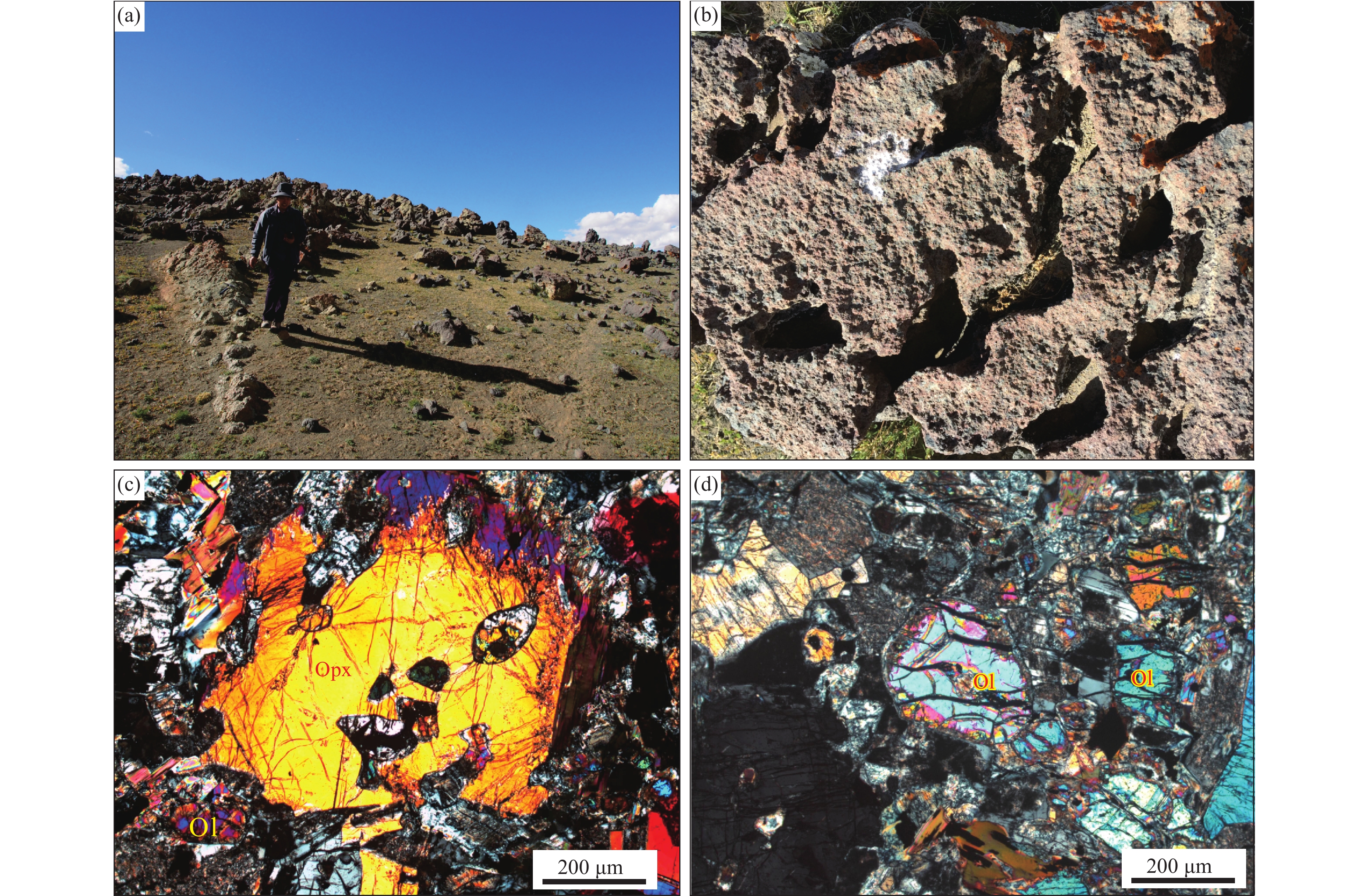| Citation: | Ya-ying Wang, Ling-sen Zeng, Ling-hao Zhao, Li-e Gao, Jia-hao Gao, Zhao-ping Hu, Hai-tao Wang, Guang-xu Li, Ying-long Di, Yu Shen, Qian Xu, 2020. Baddeleyite and zircon U-Pb ages of the ultramafic rocks in Chigu Tso area, Southeastern Tibet and their constraints on the timing of Comei Large Igneous Province, China Geology, 3, 262-268. doi: 10.31035/cg2020017 |
Baddeleyite and zircon U-Pb ages of the ultramafic rocks in Chigu Tso area, Southeastern Tibet and their constraints on the timing of Comei Large Igneous Province
-
Abstract
A suite of ultramafic and mafic rocks developed in the Chigu Tso area, eastern Tethyan Himalaya. Baddeleyite and zircon U-Pb ages acquired by SIMS and LA-ICP-MS from olivine pyroxenite rocks in the Chigu Tso area are 138.9±3.0 Ma and 139.0±1.9 Ma, respectively. These two Early Cretaceous ages are similar with the ages of the more abundant mafic rocks in the eastern Tethyan Himalaya, indicating that this suite of ultramafic and mafic rocks in the Chigu Tso area should be included in the outcrop area of the Comei Large Igneous Province (LIP). These ultramafic rocks provide significant evidence that the involvement of mantle plume/hot spot activities in the formation of the Comei LIP. Baddeleyite U-Pb dating by SIMS is one reliable and convenient method to constrain the formation time of ultramafic rocks. The dating results of baddeleyite and zircon from the olivine pyroxenite samples in this paper are consistent with each other within analytical uncertainties, suggesting that baddeleyite and zircon were both formed during the same magmatic process. The consistency of baddeleyite U-Pb ages in the Chigu Tso area with zircon U-Pb ages for a large number of Early Cretaceous mafic rocks in the eastern Tethyan Himalaya further support that zircon grains from such mafic rocks yielding Early Cretaceous ages are also magmatic in origin.
-
Keywords:
- U-Pb dating /
- baddeleyite /
- zircon /
- ultramafic rock /
- Comei Large Igneous Province /
- Kerguelen plume /
- Tethyan Himalaya /
- Geological survey engineering /
- Tibet /
- China
-

-
References
[1] Bayanova TB. 2006. Baddeleyite: A promising geochronometer for alkaline and basic magmatism. Petrology, 14(2), 187–200. doi: 10.1134/S0869591106020032 [2] Bryan SE, Ernst RE. 2008. Revised definition of Large Igneous Provinces (LIPs). Earth-Science Reviews, 86, 175–202. doi: 10.1016/j.earscirev.2007.08.008 [3] Campbell IH. 2007. Testing the plume theory. Chemical Geology, 241, 153–176. doi: 10.1016/j.chemgeo.2007.01.024 [4] Campbell IH. 2005. Large igneous provinces and the mantle plume hypothesis. Elements, 1, 265–269. doi: 10.2113/gselements.1.5.265 [5] Chen SS, Fan WM, Shi RD, Liu XH, Zhou XJ. 2018. 118–115 Ma magmatism in the Tethyan Himalaya igneous province: Constraints on Early Cretaceous rifting of the northern margin of Greater India. Earth and Planetary Science Letters, 491, 21–33. doi: 10.1016/j.jpgl.2018.03.034 [6] Ernst RE, Buchan KL, Campbell IH. 2005. Frontiers in large igneous province research. Lithos, 79, 271–297. doi: 10.1016/j.lithos.2004.09.004 [7] Heaman LM, Tarney J. 1989. U-Pb baddeleyite ages for the Scourie dyke swarm, Scotland: Evidence for two distinct intrusion events. Nature, 340(6236), 705–708. doi: 10.1038/340705a0 [8] Heaman LM, LeCheminant AN. 1993. Paragenesis and U-Pb sytematics of baddelyite (ZrO2). Chemical Geology, 110, 95–126. doi: 10.1016/0009-2541(93)90249-I [9] Heaman LM. 2009. The application of U-Pb geochronology to mafic, ultramafic and alkaline rocks: An evaluation of three mineral standards. Chemical Geology, 261, 43–52. doi: 10.1016/j.chemgeo.2008.10.021 [10] Hou KJ, Li YH, Tian YY. 2009. In situ U-Pb zircon dating using laser ablation-multi ion counting-ICP-MS. Mineral Deposits, 28, 481–492. [11] Jackson SE, Pearson NJ, Griffin WL, Belousova EA. 2004. The application of laser ablation-inductively coupled plasma-mass spectrometry to in situ U-Pb zircon geochronology. Chemical Geology, 211, 47–69. doi: 10.1016/j.chemgeo.2004.06.017 [12] Li QL, Li XH, Liu Y, Tang GQ, Yang JH, Zhu WG. 2010. Precise U-Pb and Pb-Pb dating of Phanerozoic baddeleyite by SIMS with oxygen flooding technique. Journal of Analytical Atomic Spectrometry, 25(7), 1107–1113. doi: 10.1039/b923444f [13] Li XH, Su L, Chung SL, Liu Y, Song B, Liu DY. 2006. Formation of the Jinchuan ultramafic intrusion and associated world-class Ni-Cu sulfide deposit by the ~825 Ma South China mantle plume. Geochemistry, Geophysics and Geosystem, 6, Q11004. [14] Li YG, Wang SS, Liu MW, Meng E, Wei XY, Zhao HB, Jin MQ. 2015. U-Pb dating study of baddeleyite by LA-ICP-MS: technique and application. Acta Geologica Sinica, 89(12), 2400–2418. [15] Liu YS, Gao S, Hu ZC, Gao CG, Zong KQ, Wang DB. 2010. Continental and oceanic crust recycling-induced melt-peridotite interactions in the Trans-North China Orogen: U-Pb dating, Hf isotopes and trace elements in zircons from mantle xenoliths. Journal of Petrology, 51, 537–571. doi: 10.1093/petrology/egp082 [16] Liu Z, Zhou Q, Lai Y, Qing CS, Li YX, Wu JY, Xia XB. 2015. Petrogenesis of the Early Cretaceous Laguila bimodal intrusive rocks from the Tethyan Himalaya: Implications for the break-up of Eastern Gondwana. Lithos, 236–237, 190–202. doi: 10.1016/j.lithos.2015.09.006 [17] Ludwig KR. 2003. User’s manual for Isoplot/Ex, version 3.00, A geochronological toolkit for Microsoft Excel. Berkeley Geochronology Center Special Publication, vol.4. [18] Nasdala L, Hofmeister W, Norberg N, Mattinson JM, Corfu F, Drr W, Kamo SL, Kennedy AK, Kronz A, Reiners PW, Frei D, Kosler J, Wan Y, Gtze J, Hger T, Krner A, Valley J. 2008. Zircon M257-a homogeneous natural reference material for the ion microprobe U-Pb analysis of zircon. Geostandards and Geoanalytical Research, 32, 247–265. doi: 10.1111/j.1751-908X.2008.00914.x [19] Sláma J, Kosler J, Condon DJ, Crowley JL, Gerdes A, Hanchar JM, Horstwood MSA, Morris GA, Nasdala L, Norberg N, Schaltegger U, Schoene B, Tubrett MN, Whitehouse MJ. 2008. Plesovice zircon - A new natural reference material for U-Pb and Hf isotopic microanalysis. Chemical Geology, 249, 1–35. doi: 10.1016/j.chemgeo.2007.11.005 [20] Stacey JS and Kramers JD. 1975. Approximation of terrestrial lead isotope evolution by a two-stage model. Earth and Planetary Science Letters, 26(2), 207–221. doi: 10.1016/0012-821X(75)90088-6 [21] Wang YY, Gao LE, Chen FK, Hou KJ, Wang Q, Zhao LH, Gao JH. 2016. Multiple phases of cretaceous mafic magmatism in the Gyangze-Kangma area, Tethyan Himalaya, southern Tibet. Acta Petrologica Sinica, 32, 3572–3596 (in Chinese with English abstract). [22] Wang YY, Zeng LS, Paul DA, Gao LE, Paula MA, Guo CL, Hou KJ, Tang SH. 2018. Early Cretaceous high-Ti and low-Ti mafic magmatism in Southeastern Tibet: Insights into magmatic evolution of the Comei large igneous province. Lithos, 296–299, 396–411. [23] Wingate MT, Campbell IH, Compston W, Gibson GM. 1998. Ion microprobe U-Pb ages for Neoproterozoic basaltic magmatism in south-central Australia and implications for the breakup of Rodinia. Precambrian Research, 87(3–4), 135–159. doi: 10.1016/S0301-9268(97)00072-7 [24] Wingate MTD, Compston W. 2000. Crystal orientation effects during ion microprobe U-Pb analysis of baddeleyite. Chemical Geology, 168(1–2), 75–97. doi: 10.1016/S0009-2541(00)00184-4 [25] Xia Y, Zhu DC, Wang Q, Zhao ZD, Liu D, Wang LQ, Mo XX. 2014. Picritic porphyrites and associated basalts from the remnant Comei Large Igneous Province in SE Tibet: Records of mantle-plume activity. Terra Nova, 26(6), 487–494. doi: 10.1111/ter.12124 [26] Zhang ZC, Hao YL, Wang FS. 2003. Picrites in large igneous provinces and their implications. Earth Science Frontiers, 10(3), 105–114. [27] Zhu DC, Chung SL, Mo XX, Zhao ZD, Niu YL, Song B, Yang YH. 2009. The 132 Ma Comei-Bunbury large igneous province: Remnants identified in present-day southeastern Tibet and southwestern Australia. Geology, 37(7), 583–586. doi: 10.1130/G30001A.1 [28] Zhu DC, Mo XX, Pan GT, Zhao ZD, Dong GC, Shi YR, Liao ZL, Wang LQ, Zhou CY. 2008. Petrogenesis of the earliest Early Cretaceous mafic rocks from the Cona area of the eastern Tethyan Himalaya in south Tibet: Interaction between the incubating Kerguelen plume and the eastern Greater India lithosphere? Lithos, 100(1–4), 147–173. doi: 10.1016/j.lithos.2007.06.024 [29] Zeng YC, Xu JF, Chen JL, Wang BD, Huang F, Yu HX, Chen XF, Zhao PP. 2019. Breakup of Eastern Gondwana as inferred from the Lower Cretaceous Charong dolerites in the central Tethyan Himalaya, southern Tibet. Palaeogeography, Palaeoclimatology, Palaeoecology, 515, 70–82. doi: 10.1016/j.palaeo.2017.10.010 -
Access History

-
Figure 1.
a–Sketch tectonic map of the east-central Tethyan Himalaya and eastern India showing the present locations of the Comei LIP (Zhu DC et al., 2008); b–simplified geologic map showing spatial extent and distributions of igneous rocks of the remnant Comei LIP (Zhu DC et al., 2009) and the location of the Chigu Tso complex.
-
Figure 2.
Field photographs (a) (b) and microphotographs (c) (d) showing the outcrop and mineral assemblage of ultramafic olivine pyroxenites in Chigu Tso area. Ol–olivine, Opx–orthopyroxene.
-
Figure 3.
a–Cathodoluminescence (CL) images of zircon grains; b–back-scattered electron (BSE) images of baddeleyite grains from the olivine pyroxenites in the Chigu Tso area.
-
Figure 4.
U-Pb concordia (a) and age distribution (b) diagrams for LA-ICP-MS zircon analytical results; U-Pb concordia (c) age distribution (d) diagrams for SIMS baddeleyite analytical results from the olivine pyroxenites in the Chigu Tso area.





 DownLoad:
DownLoad:


